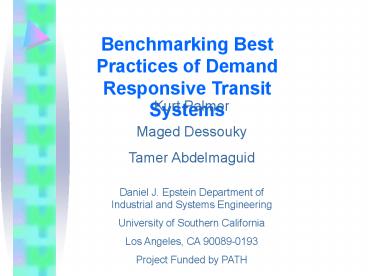List of Demographic Variables PowerPoint PPT Presentation
1 / 22
Title: List of Demographic Variables
1
Benchmarking Best Practices of Demand Responsive
Transit Systems
Kurt Palmer Maged Dessouky Tamer Abdelmaguid
Daniel J. Epstein Department of
Industrial and Systems
Engineering University of Southern California Los
Angeles, CA 90089-0193 Project Funded by PATH
2
Project Objective
- Benchmark the impact of Advanced Technologies
and Management Practices on the
Productivity, Cost Efficiency, and
Effectiveness of Demand Responsive Transit
Systems
3
Advanced Technologies
- Advanced Communications
- Automated Vehicle Location
- Automated Fare Payment
- Automated Transit Information
- Paratransit CAD System
4
Management Practices
- Financial Incentives
- Financial Penalties
- Ridesharing
- Agency Administration
- Contracted Administration
- Agency Service Delivery
- Contracted Service Delivery
- Consumer Choice
5
DRT Benchmarking Study
- Surveyed
- 180 agencies listed in 1999 NTD as serving
populations larger than 200,000 - 25 agencies from California serving
populations smaller than 200,000 - Responses
- 62 large national agencies
- 13 small California agencies
- Performance Data
- NTD years 1997, 1998, and 1999
6
Demographic Variables
- Population Density
- Passenger Trips per Capita
7
Demographic Clusters
8
Demographic Segmentation
9
Management Practices (Responding National
Agencies)
10
Financial Incentives and Penalties(Responding
National Agencies)
11
Advanced Technologies (Responding National
Agencies)
12
Performance Measures
- Productivity
- Revenue Miles per Vehicle
- Revenue Miles per Total Vehicle Mile
- Passenger Miles per Revenue Mile
- Passenger Trips per Revenue Mile
- Operating Cost
- Operating Expense per Passenger Trip
- Operating Expense per Revenue Mile
- Operating Expense per Passenger Mile
13
Average Mileage Productivity
Revenue Miles per Vehicle Revenue Miles per Total
Vehicle Mile Related to Ridesharing negative
(all years)
14
Revenue Miles Explanation
No Rideshare
10
With Rideshare
15
Revised Performance Measures
- Productivity
- Passenger Miles per Vehicle
- Passenger Trips per Vehicle
- Operating Cost
- Average Operating Cost
- Operating Expense per Passenger Trip
- Operating Expense per Passenger Mile
16
Passenger Miles per Vehicle
Related to Paratransit CAD positive
(1999,1998) National average 40,000
PassMil/Veh Average benefit 12,000 PassMil/Veh
17
Passenger Miles per Vehicle
Related to Financial Incentives negative
(1999) National average 40,000
PassMil/Veh Average detriment 7,000 PassMil/Veh
18
Passenger Trips per Vehicle
Related to Contracted Delivery negative
(1999,1997) Agency Delivery positive
(1998) National average 4950 Trips/Veh Average
benefit 1300 Trips/Veh
19
Average Operating Cost
Operating Expense per Passenger Trip Operating
Expense per Passenger Mile Related to Adv.
Communications negative (1998) National
average 18.70 /Trip 2.40
/Mile Average benefit 3.00 /Trip 0.45
/Mile
20
Average Operating Cost
Operating Expense per Passenger Trip Operating
Expense per Passenger Mile Related to Financial
Penalties positive (1999) National average
18.70 /Trip 2.40 /Mile Average
detriment 2.20 /Trip 0.30 /Mile
21
Summary of Results
- Revenue Mile problematic for Productivity
assessment - Paratransit CAD Systems beneficial for
Productivity - Agency Service Delivery beneficial for
Productivity - Financial Incentives detrimental to Productivity
22
Summary of Results
- Advanced Communications beneficial for Operating
Cost - Financial Penalties detrimental to Operating
Cost - Addition of small CA agencies does not alter
results
23
Future Work
- Update performance analysis with 2000 and 2001
NTD information - Investigate usage of Paratransit CAD
- Investigate performance metrics for Financial
Penalty/Incentive clauses - Identify other factors that agencies consider
relevant to performance

